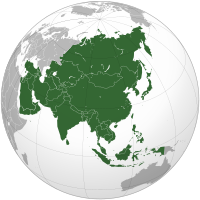
Photo from wikipedia
The roles of subduction of the Pacific plate and the big mantle wedge (BMW) in the evolution of east Asian continental margin have attracted lots of attention in past years.… Click to show full abstract
The roles of subduction of the Pacific plate and the big mantle wedge (BMW) in the evolution of east Asian continental margin have attracted lots of attention in past years. This paper reviews recent progresses regarding the composition and chemical heterogeneity of the BMW beneath eastern Asia and geochemistry of Cenozoic basalts in the region, with attempts to put forward a general model accounting for the generation of intraplate magma in a BMW system. Some key points of this review are summarized in the following. (1) Cenozoic basalts from eastern China are interpreted as a mixture of high-Si melts and low-Si melts. Wherever they are from, northeast, north or south China, Cenozoic basalts share a common low-Si basalt endmember, which is characterized by high alkali, Fe2O3T and TiO2 contents, HIMU-like trace element composition and relatively low 206Pb/204Pb compared to classic HIMU basalts. Their Nd-Hf isotopic compositions resemble that of Pacific Mantle domain and their source is composed of carbonated eclogites and peridotites. The high-Si basalt endmember is characterized by low alkali, Fe2O3T and TiO2 contents, Indian Mantle-type Pb-Nd-Hf isotopic compositions, and a predominant garnet pyroxenitic source. High-Si basalts show isotopic provinciality, with those from North China and South China displaying EM1-type and EM2-type components, respectively, while basalts from Northeast China containing both EM1- and EM2-type components. (2) The source of Cenozoic basalts from eastern China contains abundant recycled materials, including oceanic crust and lithospheric mantle components as well as carbonate sediments and water. According to their spatial distribution and deep seismic tomography, it is inferred that the recycled components are mostly from stagnant slabs in the mantle transition zone, whereas EM1 and EM2 components are from the shallow mantle. (3) Comparison of solidi of garnet pyroxenite, carbonated eclogite and peridotite with regional geotherm constrains the initial melting depth of high-Si and low-Si basalts at <100 km and ∼300 km, respectively. It is suggested that the BMW under eastern Asia is vertically heterogeneous, with the upper part containing EM1 and EM2 components and isotopically resembling the Indian mantle domain, whereas the lower part containing components derived from the Pacific mantle domain. Contents of H2O and CO2 decrease gradually from bottom to top of the BMW. (4) Melting of the BMW to generate Cenozoic intraplate basalts is triggered by decarbonization and dehydration of the slabs stagnated in the mantle transition zone.
Journal Title: Science China Earth Sciences
Year Published: 2018
Link to full text (if available)
Share on Social Media: Sign Up to like & get
recommendations!